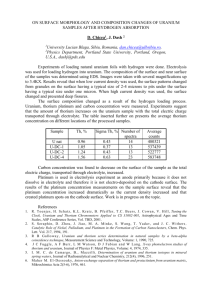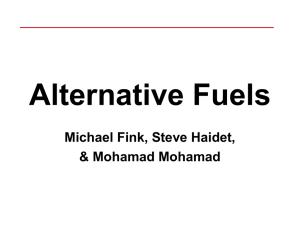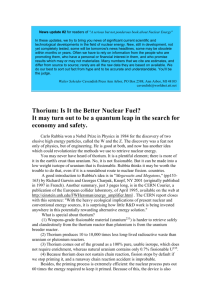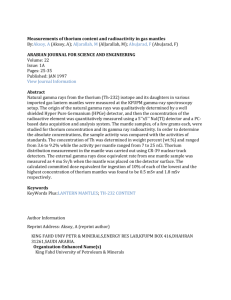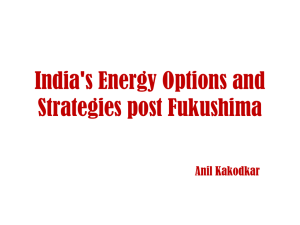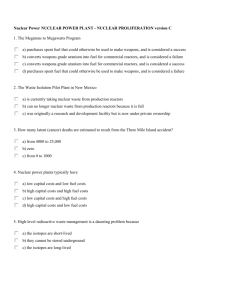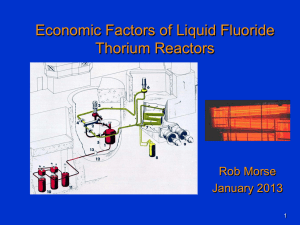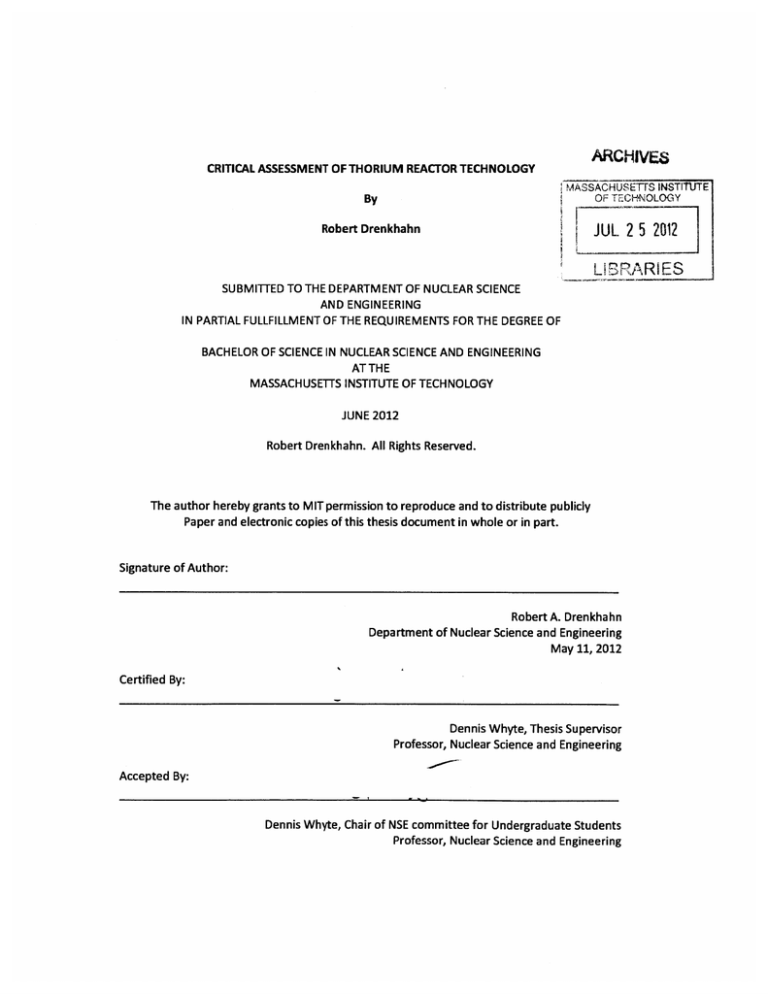
ARCHIVES
CRITICAL ASSESSMENT OF THORIUM REACTOR TECHNOLOGY
MASSACHUSETTS INSTITE
OF TECHNOLOGY
By
Robert Drenkhahn
JUL 25 2012
L1 R R 1ES
SUBMITTED TO THE DEPARTMENT OF NUCLEAR SCIENCE
AND ENGINEERING
IN PARTIAL FULLFILLMENT OF THE REQUIREMENTS FOR THE DEGREE OF
BACHELOR OF SCIENCE IN NUCLEAR SCIENCE AND ENGINEERING
AT THE
MASSACHUSETTS INSTITUTE OF TECHNOLOGY
JUNE 2012
Robert Drenkhahn. All Rights Reserved.
The author hereby grants to MIT permission to reproduce and to distribute publicly
Paper and electronic copies of this thesis document in whole or in part.
Signature of Author:
Robert A. Drenkhahn
Department of Nuclear Science and Engineering
May 11, 2012
Certified By:
Dennis Whyte, Thesis Supervisor
Professor, Nuclear Science and Engineering
Accepted By:
Dennis Whyte, Chair of NSE committee for Undergraduate Students
Professor, Nuclear Science and Engineering
2
CRITICAL ASSESSMENT OF THORIUM REACTOR TECHNOLOGY
By
Robert A. Drenkhahn
Submitted to the Department of Nuclear Science and Engineering on May 11, 2012
In Partial Fullfillment of the Requirements for the Degree of
Bachelor of Science in Nuclear Science and Engineering
Abstract
Thorium-based fuels for nuclear reactors are being considered for use with current and future
designs in both large and small-scale energy production. Thorium-232 is as abundant on Earth
as lead, far more common than all isotopes of uranium, leading to its greatly reduced cost.
Thorium itself offers a significantly greater neutron absorption cross-section than uranium at
thermal energies, resulting in greater efficiency and smaller geometries. Certain thoriumbased fuels can also significantly reduce proliferation by denaturing the thorium fuel cycle
product U-233 (which is cause for proliferation concern) with U-236 and U-238. Several
countries, including the USA, China, and India, are developing new conceptual designs which
focus on the advantages offered by thorium. Thorium reactor technology today, as well as its
practicality in the near-future, was surveyed to determine its potential for a major role in the
nuclear power industry. Factors considered were economics, efficiency, waste, and
proliferation. It is recommended that thorium-based fuels be further integrated in future
reactor designs to take advantage of its numerous benefits in these areas.
Thesis Supervisor: Dennis Whyte
Title: Professor
3
Acknowledgements
Many thanks to Professor Dennis Whyte for advising me on this thesis and for helping to solve
the always difficult problem of class scheduling. In addition, I would like to thank Professor
Michael Driscoll for his input when deciding on a thesis topic.
A special thank you to my peers throughout my classes, including those with whom I worked
with on the very enjoyable design project in the fall term of 2011. Specifically, I would like to
thank Brendan Ensor for interesting me in nuclear engineering and for his academic and
personal advice.
4
Table of Contents
Abstract .........................................................................................................................................
3
Acknowledgements.......................................................................................................................
4
List of Figures ................................................................................................................................
6
List of Tables..................................................................................................................................
7
CHAPTER 1: Introduction ..............................................................................................................
8
CHAPTER 2 ...................................................................................................................................
10
Background .................................................................................................................................
10
2.1 History ...............................................................................................................................
10
2.2 The Thorium Fuel Cycle .................................................................................................
11
2.2 Cost and Abundance .....................................................................................................
12
2.3 Proliferation Concerns ...................................................................................................
16
2.4 Safety Advantages.............................................................................................................
17
2.5 Potential Disadvantages.................................................................................................
18
CHAPTER 3...................................................................................................................................
19
Objectives....................................................................................................................................19
CHAPTER 4...................................................................................................................................21
M ethods......................................................................................................................................21
4.1 Identifying Potential Advantages....................................................................................
21
4.2 M odeling an Exam ple in M CNP......................................................................................
21
4.3 The Lead-Bismuth Eutectic Cooled Reactor ..................................................................
22
4.4 The Thorium-Based Fuels...............................................................................................
23
CHAPTER 5...................................................................................................................................25
Results and Discussion ................................................................................................................
25
5.1 Data...................................................................................................................................
25
5.1 Discussion..........................................................................................................................
27
CHAPTER 6 ...................................................................................................................................
30
Conclusion ...................................................................................................................................
30
References ...................................................................................................................................
31
5
List of Figures
Figure 1- Thorium Fuel Cycle producing uranium-233 which, upon fission, produces a neutron
to continue the cycle.............................................................10
Figure 2 - Comparison of the neutron cross sections for thorium-232 (red) and uranium-238
(green). ......................................................................
13
Figure 3 - Neutron Yield for uranium-233, uranium-235, and plutonium-239 ..............
14
Figure 4 - An example of a Lead-Bismuth Eutectic cooled core with a hexagonal array of
assemblies................................................................
22
Figure 5 - K-effective as a percentage of control rod insertion, with 100% being fully
withdrawn...........................................................
.24
Figure 6 - k-effective measurements for the thorium fuels, keeping all else equal relative to the
uranium mononitride simulation..................................................25
6
List of Tables
Table 1 - Estimated thorium reserves for select countries ............................
12
Table 2 - Various k-effective measurements for thorium fuels ..........................
26
7
CHAPTER 1: Introduction
The race for practical Generation IV reactor designs continues; one such technology
that shows potential is a thorium-fueled reactor. Though uranium-fueled reactors have
dominated the industry, economic and political pressures have opened up the possibility that
thorium-fueled reactor designs could compete in today's energy market. Though thorium has
been demonstrated successfully in reactors as early as the 1960's, uranium came to dominate
the industry as a result of the need for breeding isotopes for military use (i.e. thermonuclear
weapons), as well as developing nuclear technology quickly in the face of the Cold War [1].
However, major disadvantages are present in the current designs which use uranium fuels.
For instance, heat and radiation damage to the fuel assemblies requires high turnover of fuel
rods and, as a result, only about 5% of the energy contained in the uranium is used.
Additionally, the fission byproducts of the uranium fuel cycle significantly affect the efficiency
of the reactor. One example of such a byproduct is the well-known fission poison xenon-135,
which with a high neutron cross-section absorbs many of the neutrons that otherwise could
have been used in uranium fission.
Global energy usage will continue to increase, requiring an increase in nations' ability
to supply to the electrical grid. Though other forms of energy (i.e. coal, natural gas) are
currently dominating the energy industry, political trends are moving towards cleaner forms of
energy - those sources which produce the fewest carbon emissions and have the least impact
on the environment. Fortunately, nuclear power eliminates the risk of carbon emissions in the
production of electrical power, making it attractive regardless of the fuel used. Currently
8
licensed designs have high capital costs, however, necessitating new research into lessening
the financial burden associated with building new plants.
The numerous potential advantages offered by thorium reactor technologies (i.e. cost,
safety, proliferation, efficiency) are being explored in several countries today. As new thorium
concepts are developed that can overcome economic and regulatory hurdles, it may replace
uranium as the dominate fuel in nuclear reactors. A critical assessment of thorium nuclear
reactors today is needed to draw comparisons with more common uranium reactors and
identify advantages provided by an industry focus on thorium-based designs. Whether these
advantages merit the expedited development of thorium reactors as part of the energy
portfolio of the United States and other countries is still in question. Much work is still being
done to look at the implementation of thorium-based fuels in current and future reactor
designs, and whether the inclusion of thorium will boost the competitiveness of nuclear power
in the global energy market.
9
CHAPTER 2
Background
2.1 History
Thorium was discovered in 1828 by a Swedish chemist named Jons Jacob Berzelius [2].
It was confirmed to be radioactive by Marie Curie before the turn of the 20th century, although
the radioactivity is very low, with a half-life of about 15 billion years. As an oxide (ThO 2 ), it has
a higher melting point (3663K) than any other oxide. Naturally occurring thorium-232 is more
than three times more abundant than uranium in the Earth's crust (Noting that even the fissile
material in natural uranium is only a small fraction (0.7%) of what is mined) [3]. In contrast,
almost all of naturally occurring thorium is the desired fertile thorium-232 needed to breed
fuels for power production [2].
Many reactor designs have been tested for use with thorium-based fuels. One notable
example was the US Molten-Salt Reactor Experiment in the 1960's which used uranium-233 as
its fissile fuel, bred from thorium [4]. This project showed some feasibility of the thorium
cycle, but it was later defunded. For most of the 2
0
th
century, breeding nuclear materials for
weapons was of more concern and this fuel cycle was passed over in favor of uranium. As a
result, much of the nuclear power infrastructure grew out of the bureaucratic decision to
pursue uranium fuels [2].
Today, much of the focus on improving nuclear technology is reducing cost to compete
with fossil fuels, increasing proliferation resistance, and ensuring safety. These factors make it
10
necessary to take a second look at thorium as a nuclear fuel-cycle option. If research into
modern designs can show thorium to have a superior advantage to uranium-based fuels, it
may merit a shift in the nuclear power infrastructure of the United States, as well as other
countries around the world.
2.2 The Thorium Fuel Cycle
Thorium is fertile, meaning that on the addition of a neutron source it transmutes to uranium233 before it becomes fissile [3]. A description of the thorium fuel cycle is shown in Figure 1.
O
p-decay
+
s-decay
e
n
U-233
e
Pa-233
n 0 +.
Th-233
Th-232
Figure 1- Thorium Fuel Cycle (coloration is arbitrary). A source neutron
transmutes Th-232 which, after a series of beta-decays, produces U-233. This isotope fissions
when induced by thermal neutrons, producing more neutrons (2-2.5) to continue the cycle
Upon the addition of a neutron (meaning a neutron source is require), thorium-232 becomes
unstable thorium-233 which quickly beta decays to protactinium-233. After about another
month, this beta decays once more to become the uranium-233 fissile fuel, producing
11
neutrons upon fission to continue the cycle. Operating this fuel cycle in the thermal neutron
spectrum allows for improved safety and control over the uranium-238 reactors operating in
the fast spectrum. The fission product wastes produced are created to a lesser extent than a
uranium-fueled counterpart. The uranium-233 has a small probability, upon absorption of a
neutron, to become uranium-244 [3]. This isotope can again absorb a neutron to become the
fissile isotope uranium-255, which either fissions as fuel or produces progressively higher
isotopes, including fissile plutonium-239. Of waste concern, however, is the Protactinium-231
(half-life of 32,760 years), which is created in a (n,2n) reaction with thorium-232 which decays
to form the isotope in question, contributing much of the long-term radiotoxicity of the spent
fuel.
2.2 Cost and Abundance
Thorium offers a significant cost advantage over uranium-based fuels, boosted
especially by its abundance. Also, due to the inevitable decline of the relatively little fissile
uranium available (which makes up 0.7% of natural uranium), the cost of uranium fuel for
reactors will begin to increase as supply runs short. Fertile thorium will remain plentiful for a
much longer period of time, ensuring that there will be no 'peak thorium' as there is
potentially with oil and uranium. It already is mined from Monazite sands, although in this
process it is currently considered a byproduct [5]. As a comparison, uranium costs about $121
per kilogram, while thorium is much cheaper. Although it does not have an official commercial
quote, it is estimated to be around $33 per kilogram should it be mined for commercial use. It
is currently in such low demand that a few thousand tons of thorium nitrate were simply
12
buried in the Nevada desert. An estimation of the thorium reserves of a few select countries is
listed in Table 1.
Country
Reserve Base (tons)
Australia
340,000
India
USA
Norway
300,000
300,000
180,000
Canada
100,000
South Africa
Brazil
Other Countries
World Total
39,000
18,000
100,000
1,400,000
Table 1- Estimated thorium reserves for select countries [6]
The entire energy need of the United States can possibly be satisfied by as little as 400 tons of
thorium per year [6]. This would mean that the domestic supply of thorium in the United
States could last for hundreds if not over a thousand years. This is also assuming thorium
being used for all of the country's energy needs; however it would be more accurate to
assume a mixed portfolio of energy sources to make up the country's total power demand.
Thorium also offers higher neutron absorption cross-sections at thermal energies [3].
This allows for more efficient fuel-burning and smaller geometries which lead to lower overall
design costs. A comparison of the neutron cross sections for thorium-232 and uranium-238
are given in Figure 2.
13
E+3
.0
E+2
E+31
...........
E+0
E-5
E-4
E-3 -E-2
E-1 E+0 E+1
+
+
+4E
+
Incident Ee"(V
Figure 2 - Comparison of the neutron cross sections for thorium-232 (red)
and uranium-238 (green). Obtained using the National Nuclear Data Center Database [7]
There is a visible difference in the thermal neutron spectrum for these two cross-sections that
can be taken advantage of in core designs. With a higher absorption cross-section, the chance
of a neutron escaping the core, and thus becoming unusable, decreases. This reduces the
need for sophisticated reflectors or large geometries to account for neutron leakage.
Upon absorption, the thorium becomes uranium-233, a fissile isotope ideal for nuclear
power generation. In comparison to uranium reactors which utilize uranium-235 and
plutonium-239 as their fissile fuels, uranium-233 produces a significantly higher yield of
14
neutrons from fission than U-235, and to a slightly lesser extent, Pu-239. A plot of the neutron
yields for these three isotopes is shown in Figure 3.
Figure 3 - Neutron Yield for uranium-233, uranium-235, and plutonium-239 [8]
This property reveals a very practical use for the thorium fuel cycle. With a thermal spectrum
neutron cross-section much higher than 2, the thorium reactor becomes capable of being a
breeding reactor. This means that it creates more fissile material than it consumes, and
becomes highly efficient at using all of the nuclear fuel contained within [9]. By comparison,
once-through Light Water Reactors (LWRs) use about 1% of the energy contained in their fuel.
This is not only increases efficiency, but lessens waste and prevents the fuel cost from
increasing over significant amounts of time.
15
Some analysis of a heterogeneous design using thorium and uranium (i.e. in a seed
and blanket arrangement) suggests cost savings over the traditional PWR using U02 [10]. This
seed (uranium) and blanket (thorium) design was explored by Radkowsky and exploited the
uranium seed to provide neutrons to the thorium, allowing the breeding of uranium-233 fuel.
A fuel-cycle cost analysis showed that the Radkowsky design was 4% lower than a traditional
PWR, though many uncertainties could affect this outcome, along with economic changes such
as material cost, mining cost, etc.
Overcoming the cost hurdle is imperative in competing with fossil fuels which
currently have the advantage in upfront capital costs of producing a viable plant. If thoriumbased fuels can lower not only fuel costs, but the capital cost as well (i.e. through not requiring
large facilities, pressurizers and other expensive add-ons in some cases, etc.), it can be a very
attractive candidate to produce a large portion of the world's power.
2.3 Proliferation Concerns
Another concern, which is more significant today, is nuclear proliferation. Uranium
reactors produce waste products which can be used as the material in nuclear weapons,
causing serious security concerns. Pressurized Water Reactors (PWRs) fueled with enriched U235 produce a majority of the world's nuclear power [11]. As a result, significant amounts of
plutonium are produced, as well as smaller amounts of neptunium, americium, and curium.
Some thorium reactor technologies can burn these by-products along with the thorium to
alleviate this risk [12]. The thorium-232 fuel cycle reduces waste production when used with a
16
thermal neutron spectrum. In cases where uranium-233 produced by the fertile thorium is a
weapons risk, denaturing the thorium fuel has been proposed to alleviate the risk of
conversion to weapons-usable material. The Radkowsky design mentioned above
demonstrated a significant reduction (about 80%) in the amount of plutonium remaining in the
spent fuel [10]. Also, the plutonium present had a larger amount of those isotopes not useful
in nuclear weapons production - spontaneous fission of plutonium-240 and plutonium-242
lessen the explosive yield of a potential bomb. Uranium-232 produced from the thorium
creates gamma radiation which also makes handling the material for the purpose of a weapon
difficult.
2.4 Safety Advantages
Thorium reactors have an added boost to safety because of their higher melting point
and fuel thermal conductivity (In the case of thorium oxide, 5.1 W/mK at 773K and 3.0 W/mK
at 1273K) [13]. These characteristics allow for a greater upper threshold for output
temperatures, especially important in an accident scenario. The increase in thermal
conductivity allows the thorium core to shed heat more readily to the coolant. Also relevant in
certain thorium designs which utilize a liquid fuel is the added safety from not requiring a high
pressure environment as is the case in PWRs [1]. Liquid-fuel reactors also provide the option
of adding a freeze plug at the bottom of the reactor vessel in the event of a runaway
temperature scenario, which can dispel the liquid fuel into a subcritical geometry.
17
2.5 Potential Disadvantages
Use of thorium-232 fuels as well as those that are thorium-232 and uranium-233 mixes
can result in the creation of small amounts of uranium-232 [3]. Many of the decay products of
this isotope are strong gamma emitters, causing biological concern for any workers at the
reactor plant. However, this does offer an added proliferation resistance, due to the fact that
it increases the danger to any person trying to acquire the materials from the spent nuclear
fuel.
A major drawback in using the thorium fuel cycle is that it is merely a fertile material,
thus requiring a kick start from a fissile isotope to begin the chain [13]. Such examples of an
isotope include uranium-235 or plutonium-239, but one must enrich uranium-235 for practical
use (which is difficult from a regulatory standpoint). Otherwise, uranium-233 must be created
from pure thorium before reactor start-up, creating inefficiency at the beginning of the reactor
life-cycle.
18
CHAPTER 3
Objectives
Though thorium-fueled reactors have already been demonstrated, the designs were
not often feasible and/or failed to compete economically with uranium reactors. However,
with new reactor designs using state-of-the-art materials, these challenges can be overcome in
the near-future. This thesis will seek to accomplish a number of goals:
1. Gather information on the qualities of thorium-based fuels being taken advantage
of today.
2.
Compare these characteristics of thorium fuel with that of the traditional uraniumfuel reactors.
3.
Simulate a scenario in which thorium fuel is used in a more modern design of a
nuclear power plant.
4.
Compare this outcome with that of the same reactor using a uranium fuel.
5.
Determine what advantages a thorium-based fuel could offer
6. Offer recommendations as to whether or not thorium fuel should be more
commonly implemented for future reactor designs.
The advantages most desirable are those relating to cost, efficiency, safety, and
proliferation, though other factors may be considered. Though there are a plethora of reactor
designs, the aim is to evaluate the potential for thorium to replace uranium in a nuclear power
19
reactor, and the reactor design chosen will offer a particular instance where thorium can be
implemented successfully.
20
CHAPTER 4
Methods
4.1 Identifying Potential Advantages
Literature on thorium reactor technology will be examined to gather information on
various uses of thorium in commercial nuclear reactors. In addition, research into details such
as cost, proliferation, safety, as well as the associated properties of uranium fuels will be
needed to provide a comparison between the two options. In order to consider strong
support for the use of thorium fuels in future reactor projects, a significant advantage and
ease of transition is required. This information will form the qualitative portion of this
assessment.
4.2 Modeling an Example in MCNP
A thorium reactor concept is modeled in the Monte Carlo N-Particle Transport Code,
or MCNP [14]. The core model consists of a defined geometry and material specification,
along with associated cross section data. Input files allow the user to define individual cells
and surfaces, assigning material value integers to create the layout of the given design. MCNP
then tracks neutron histories from creation using cross section data libraries which give those
cross sections for elastic scattering, inelastic scattering, and absorption for the materials
present in the design.
21
Simulations will confirm the plausibility of thorium fuel in this reactor setup through
Monte Carlo analysis, determining a comparative k-effective value using various fuel blends.
This can be compared to the original uranium-based fuel design to show any reduction of cost
due to cheaper fuel (both price of the fuel and the amount required for a given geometry for a
self-sustaining reaction will be taken into account). K-effective, the multiplication factor, is
defined as the ratio of thermal neutrons that induce fission from one generation to the next,
and can also be related to the six-factor formula shown in Equation 1.
kej
= E Lf p Ltf
(1)
In this formula, k-eff represents the multiplication factor, E is the fast fission factor, Lf is the
fast spectrum non-leakage probability, p is the resonance escape probability, Lt is the thermal
spectrum non-leakage probability,f is the thermal utilization factor, and ri is the reproduction
factor (number of fission neutrons per absorption) [15]. Providing this quantitative analysis
will strengthen an eventual recommendation as to the attractiveness of a switch to thorium
fuels.
4.3 The Lead-Bismuth Eutectic Cooled Reactor
A lead-bismuth eutectic cooled fast reactor was recently explored at MIT [16]. The
original design calls for uranium mononitride (UN) fuel and a T91 steel clad. An example of the
core's hexagonal shape is shown in Figure 4. Twelve rings of assemblies hold fuel pins, boron
carbide control rods, a magnesium oxide reflector, as well as a boron carbide shield. LeadBismuth eutectic coolant surrounds the arrangement and flows between assemblies.
22
*
Blac- Fuel Regions
-
Purple-Control Rods (84C)
Red-Shield (B Q
*Orange- Ccclnt (LBE)
Note the Blue containment is
not the actual containment (in
reality it is larger)
Figure 4 - An example of a Lead-Bismuth Eutectic cooled core
with a hexagonal array of assemblies [16]
Uranium mononitride is a typical fuel in commercial nuclear reactors, with a high melting point
and superior thermal conductivity to uranium dioxide. The fuel rods in this previous analysis
were partitioned into different enrichment zones, with higher enrichment in the bottom twothirds of each fuel rod (about 2.5% more enrichment in this zone).
4.4 The Thorium-Based Fuels
The thorium-based fuels chosen to experiment with inside the core design were an assortment
of fuel mixtures. One of these was 95% thorium oxide (ThO 2) and 5% plutonium oxide (PuO 2).
The plutonium is present to supply neutrons to the thorium to allow its transmutation to
23
uranium-233 for fuel. This also allows for surplus plutonium to be used for the purpose of
creating energy, instead of being stored away and at risk of theft. Thus, using the plutonium
reduces the proliferation of nuclear materials that could potential be used for weapons.
A second set of fuels used varying mixtures of thorium-232 and uranium-233 oxides in
three molecular densities - 50% ThO 2 and 50% U2330 2, 90% ThO 2 and 10% U2330 2, as well as
97% ThO 2 and 3% U2330 2. Each fuel was simulated to determine a difference in k-effective
with all other factors equal. These values were plotted to observe their relative change from
the uranium mononitride results.
24
CHAPTER 5
Results and Discussion
5.1 Data
The results of the uranium mononitride fuel in the lead-bismuth eutectic cooled reactor are
shown in Figure 5.
K-effectivevs. Rod Withdrawal Percentage
1.05
0.95
0.9
0.85
0
20
40
60
80
100
Rod Witbdrawal %
Figure 5- K-effective as a percentage of control rod
insertion, with 100% being fully withdrawn [16]
The core was designed such that the control rods, when fully withdrawn, would allow for
criticality and when fully inserted, would be subcritical. The red line denotes the border of the
two enrichments zones in the fuel rods. Figure 6 displays a collection of the k-effective
measurements for various percentages of control rod insertion for each of the thorium-based
fuels (95%ThO 2-5%PuO 2, 50%ThO 2-50%U2330 2, 90%ThO 2-10%U2330 2, 97%ThO 2-3%U
25
233
0 2 ).
Thorium-Based Fuel Results
2.5
2
U
0
.mE
U
U
U
A
A
A
1.5
*95%ThO2-5%PuO2
U
S
A
*50%ThO2-50%UO2
A90%ThO2-10%UO2
- 97%ThO2-3%UO2
0.5
0
0
10
20
30
40
50
60
70
80
90
100
Percentage Control Rod Withdrawal
Figure 6 - K-effective measurements for the thorium fuels in the hexagonal
core, keeping all else equal relative to the uranium mononitride simulation
K-effective is shown along the y-axis with a value of 1 (criticality) highlighted in bold.
Measurements were taken at a range of percentages in which the fuel rods were withdrawn,
including fully inserted and fully withdrawn scenarios. A list of the range of values at these
percentages are presented in Table 2.
26
K-effective for Thorium Fuels at Various Control Rod Positions
Percent Withdrawn
0
10
20
25
30
40
50
60
75
95%ThO2-5%PuO2 50%ThO2-50%UO2
0.42
1.822
0.425
1.83
0.436
1.85
0.446
1.868
0.454
1.884
0.47
1.913
0.477
1.931
0.485
1.95
0.49
1.964
100
0.5
1.977
90%ThO2-10%UO2
1.198
1.2
1.225
1.243
1.264
97%ThO2-3%UO2
0.356
0.358
0.37
0.38
0.389
1.295
1.315
1.33
1.347
1.36
0.402
0.411
0.418
0.424
0.43
Table 2 - Various k-effective measurements for thorium fuels
The values listed feature values both of higher and lower k-effective values than the uranium
mononitride data set.
5.1 Discussion
The value of k-effective determines whether there is an exponential change (growth or
decay) present in the neutron population. Therefore, the range needed in a nuclear core must
contain a range of values both above and below 1. Choosing various blends of thorium and
uranium-233 helps to understand how much the thorium must be prepared (bred to uranium233) in order to achieve a mix that encompasses the required k-effective value (noting that it
only specifically applies for this reactor design). There are two choices when trying to
approach this ideal range. First, the designer can simply find a ratio of materials in the fuel
that solves the problem. The second option is to alter the design to raise or lower the
contribution of the six factors in Formula 1. This is of particular interest if there is an
27
economical mix of thorium-uranium that has a higher k-effective than the original uranium
fuel, because the reactor can potentially be simplified or made smaller (increasing neutron
leakage) to bring the value range of k-effective down. This can possibly create savings that
offset the cost of processing the thorium to create the desired fuel (keeping in mind that
natural thorium is inherently cheaper than uranium to begin with).
In the mixture of thorium and uranium-233 with the ratio or 90%-10%, the range is
quite close to what one would need. Reducing the size of the core can allow for increased
neutron loss to leakage and reduce the k-effective range. This would, however, reduce the
amount of energy being transferred to the coolant.
Though thorium has been showed to offer advantages in proliferation resistance, a
more important factor to consider is cost. To produce a fuel of these types can be expensive,
and any advantages should be considered to help nuclear compete against other sources of
energy. A given quote of a uranium oxide fuel was as high as 1600 dollars per kilogram [17].
This high cost is due to the amount of processing and enriching that must take place to get a
usable fuel. Uranium mononitride is even more expensive to produce, so if thorium maintains
its cost advantage over uranium oxides, it would be able to replace uranium mononitride to
reduce costs in this instance. The cost of producing a thorium fuel with uranium-233 to begin
the fuel-cycle is also quite expensive. Some studies have shown that even with the high cost
of fabricating the uranium-233 fuel, the cost still falls short of enriched uranium fuels [18].
Using thorium in this lead-bismuth cooled reactor may not be the most ideal use,
though, as many argue for liquid fluoride thorium fuel designs [1]. Such designs are theorized
to be able to produce 1GW of power for as little as 1 million dollars (US) per year [20]. This is
28
compared to 30 million dollars per year with a uranium plant of similar power output. These
reactors also reduce capital costs (the most critical requirement in competing economically)
from over a billion dollars to around 250 million dollars (This is due to a lack of shielding
required and meltdown resistance offered form these molten-salt designs). Their proliferation
resistance reduces security forces, and they also require less maintenance, further driving
down operational costs (A comparison table of costs is presented in the appendix). It is also
noted that an advantage of thorium reactors is to use a large quantity of smaller reactors to
produce larger energy outputs, instead of the gigantic LWRs in use today. These reactors
could take advantage of high thermal efficiency to further reduce the cost of operation, in
addition to their strengths in safety and proliferation resistance. Should thorium reactor
technology be developed extensively, the economic advantages are potentially tremendous.
29
CHAPTER 6
Conclusion
Various experiments using thorium as a nuclear fuel have been studied to find the
numerous advantages that can be taken advantage of to help improve the position of the
nuclear power industry. Using this fuel cycle can lead to smaller and more efficient reactors to
suit energy needs. Arbitrary blends of thorium fuels with uranium-233 have been shown
plausible in a lead-bismuth cooled reactor, though many numerous designs may also find
advantages with this fuel. The thorium fuel option is important to continue studying,
especially with the primary concerns of today being energy independence, environmental
safety, and non-proliferation of nuclear materials. The energy situation has changed such that
nuclear power has a unique opportunity to take a leading role in producing the world's power
demand. Economic competitiveness is essential, while continuing to pursue safe and efficient
designs. Thorium fuel has been found to possess many attributes that give advantages to cost,
safety, efficiency, and proliferation. For these reasons, it is recommended that thorium fuels
be included in future designs in order to ensure the most competitive cost for nuclear power
plants in the energy market.
Future work should continue to exploit qualities of thorium fuel that drive down costs,
both capital and operational. If a major advantage can be gained economically over other
sources of energy (i.e. coal, oil, natural gas), nuclear power can come to dominate the energy
portfolio of the United States and other nations as well.
30
References
[1] Hargraves, Robert and Moire, Ralph, Liquid Fluoride Thorium Reactors,
http://www.thoriumenergyalliance.com/downloads/AmericanScientistHargraves.p
df
[2] The Liquid Flouride Thorium Reactor: What Fusion Wanted To Be. Dr Bonometti. Google
Tech Talks. November 18, 2008. <http://www.youtube.com/watch?v=AHs2Ugxo7-8>
[3] Thorium fuel cycle - Potential benefits and challenges, IAEA, VIENNA, 2005, <http://wwwpub.iaea.org/mtcd/publications/pdf/te_1450_web.pdf>
[4] Haubenreich, Paul. Experience with the Molten-Salt Reactor Experiment. Oak Ridge
National Lab 1969.
<http://www.energyfromthorium.com/pdf/NATMSREexperience.pdf>
[5] Thorium- A New Direction in Power Generation. July 2011.
<http://johnpreedy.blogspot.com/2011/07/thorium-new-paradigm-inpower_15.html>
[6} U.S. Geological Survey, Mineral Commodity Summaries, January 2008.
[7] National Nuclear Data Center. Brookhaven National Laboratory.
<http://www.nndc.bnl.gov>
[8] Thorium as a Nuclear Fuel. Course 22.251. Fall 2005.
<http://www.core.org.cn/NR/rdonlyres/45CE41D-DAE2-4FF4-ACA1F2474EDE9A45/0/lecl8.pdf>
[9] Cohen, Bernard. Breeder Reactors: A Renewable Energy Source. Jan. 1983.
<http://www.sustainablenuclear.org/PADs/pad11983cohen.pdf>
[10] Kasten, Paul, Review of the Radkowsky Thorium Reactor Concept, 1998,
<http://www.princeton.edu/sgs/publications/sgs/pdf/7_3kasten.pdf>
[11] Nuttin et. al., Potential of Thorium Molten Salt Reactors,
<http://hal.archives-ouvertes.fr/docs/00/02/55/24/PDF/democrite-00021911.pdf>
[12] Thorenco LLC, 369 Pine St. Suite 600, San Francisco, CA 94104,
<http://thorenco.com/technologies.html>
[13] Kazimi et. a/., On the Use of Thorium In Light Water Reactors, 1999,
<http://www.thoriumpower.com/files/mit%20article%20april%201999.pdf>
31
[14] Monte Carlo N-Particle Transport Code. Los Alamos National Laboratory.
<mcnp-green.lani.gov/>
[15] Duderstadt, James; Hamilton, Louis (1976). Nuclear Reactor Analysis. John Wiley & Sons,
Inc.
[16] Harris and Laderman et. al. Considerations in Designing a Nuclear Power Plant with a
Hydrogen and Biofuels Facility. Massachusetts Institute of Technology. Dec 2011.
[17] Thorium Costs. <http://www.thorium.tv/en/thorium-costs/thoriumcosts.php>
[18] Neopanora Institute-Network of Energy Technologies.
<http://www.neopanora.com/en/thorium.html>
[19] The Future of the Nuclear Fuel Cycle. Massachusetts Institute of Technology. 2011.
<http://web.mit.edu/mitei/research/studies/documents/nuclear-fuelcycle/TheNuclearFuel_Cycle-all.pdf>
[20] Nicholas, Fraser. Thorium Cost-Benefit Analysis.
http://policyprojects.ac.nz/frasernicholas/cost-benefit-analysis/
32
APPENDIX
Cost Type
Uranium LWR
Capital Cost (millions/yr)
1100
Fueling Cost (millions/yr)
30
Maintenance/Staffing Cost (millions/yr)
50
Cost Estimates of a Uranium LWR and a LFTR [20]
33
Liquid Flouride
Thorium Reactor
(LFTR)
250
1
5

